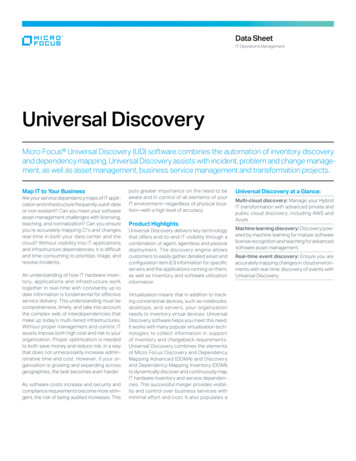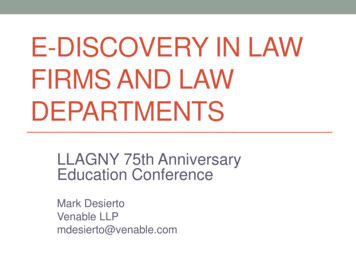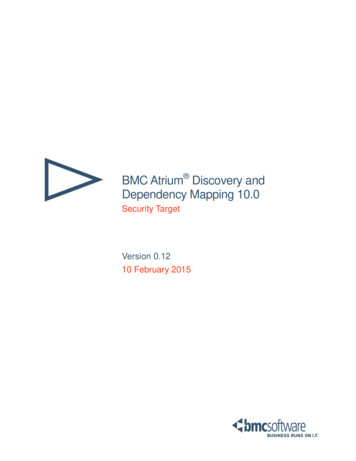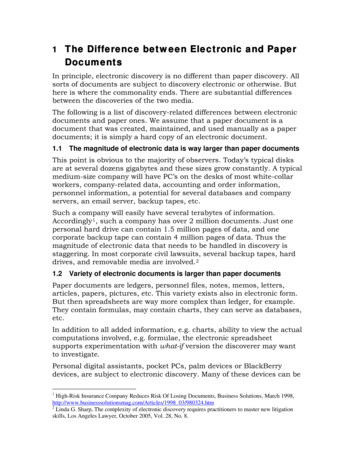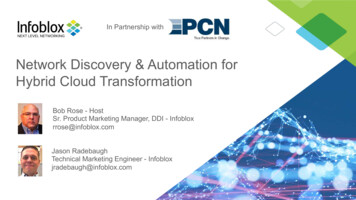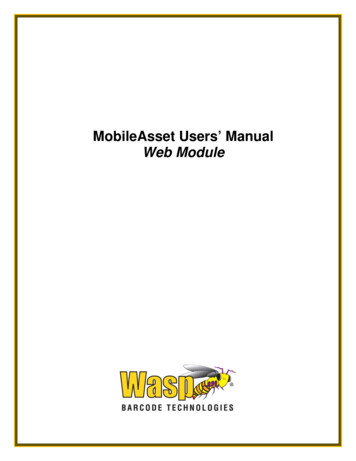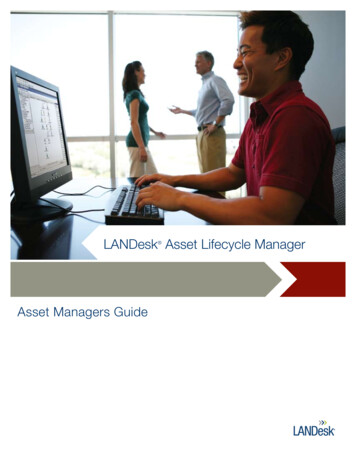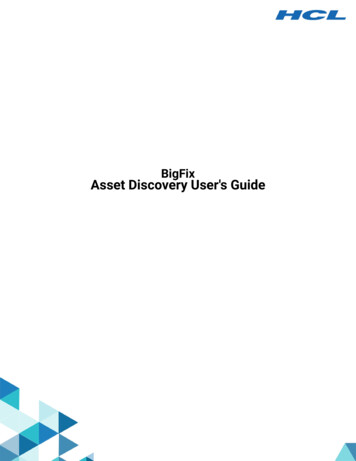
Transcription
BigFixAsset Discovery User's Guide
Special noticeBefore using this information and the product it supports, read the information in Notices(on page 45).
Edition noticeThis edition applies to BigFix version 10 and to all subsequent releases and modificationsuntil otherwise indicated in new editions.
Chapter 1. Setting up your environmentLearn how BigFix Asset Discovery works.BigFix Asset Discovery has some key uses in enterprise environments: Identification of network assets, including devices such as routers, printers, switches,wireless access points, or anything with an IP address. Identification of unmanaged and rogue computers including computers that have hadthe BigFix agent disabled or rogue computers that are not managed by the company.With this information, important license inventory questions can be answered regardingwhat kind of device it is, when it was installed and where it is located. Additionally, securityquestions and concerns can be answered regarding unauthorized employee computers,wireless units or rogue devices on the network.The BigFix Asset Discovery solution is unique because the scanning is done by other agentsof nearby computers. This is known as distributed scanning. This approach has several keybenefits: Conserves WAN bandwidth Scanning can be done in parallel for much faster results, in minutes instead of weeks Can be easily customized to work in complex network configurations, including isolatedsubnets Individual subnets can run customized scan typesBigFix Asset Discovery works by using Fixlet and Tasks to deploy Scan Points to specifiedagents in your network. You can then use other Fixlets and Tasks to run Nmap scans atintervals of your choosing. Scan results are automatically sent to the BigFix server, whichimports the data into the BigFix database. The scan information can then be viewed in theBigFix console using the Unmanaged Assets tab.Note: On Linux platforms, you must install the BES Server Plugin Service to work withthe Asset Discovery Fixlets. This plug-in is available for installation in the BigFix Supportsite.
Chapter 2. OverviewA brief overview on how BigFix discovers assets and on what are Scan Points.BigFix Asset Discovery works by designating certain computers as Scan Points. Any agentcan be designated as a Scan Point if it is running a supported operating system. These ScanPoints query the unmanaged assets in your network. The following image illustrates thisprocess.Information is retrieved from these unmanaged assets by the Scan Points and sent backthrough relays to the database on the BigFix server. From there, you can examine the resultson the BigFix console:
BigFix Asset Discovery User's Guide 2 - Overview 6System requirementsScan Point hardware and software requirementsBigFix Asset Discovery supports Windows 7, Windows Vista, Windows 2008, Windows 2012,Windows 2016, Windows 2019, Windows 8, Windows 10 or Red Hat Enterprise Linux 6, RedHat Enterprise Linux 7 and Red Hat Enterprise Linux 8, x86-64 architectures.As a prerequisite for using a Scan Point on Red Hat Enterprise Linux 8, x86-64 architecture,you must install the compat-openssl10.x86-64 package.Moreover, with an old Nmap version, BigFix Asset Discovery also supports Red Hat Linux 5,CentOS 5 and Linux Tiny Core 8.2.
BigFix Asset Discovery User's Guide 2 - Overview 7BigFix Asset Discovery does not support Amazon Linux 2.The nmap.org website indicates that Nmap supports Windows 7 and later, as well asWindows Server 2008 and later. Nmap supports also Linux operating systems.InstallationTasks to perform to complete a successful installation.You can perform the following installation tasks in the Asset Discovery site: Enable the Unmanaged Asset Importer Service on your BigFix server. Designate specific agents as scan points. Run the scan.Note: To view Unmanaged Assets, you must have the proper permissions set throughthe Administration Tool. To access the tool, click Start All Programs BigFix Enterprise BES Administration Tool). A user can be granted permission to view all unmanaged assetsor only those connected to the Scan Points that they administer.Note: On Linux platforms, you must install the BES Server Plugin Service to work withthe Asset Discovery Fixlets. This plug-in is available on the BigFix Support site.Installing the siteSteps to perform to enable and subscribe all the computers to the external site.To enable and subscribe all the computers to the external site using the BigFix Console,perform the following steps:1. Open the BigFix Management domain and scroll to the top to view the associateddashboards.2. In the Licensing dashboard, click the external site and enable it, if not already enabled,by clicking the name of the site in the list of sites.
BigFix Asset Discovery User's Guide 2 - Overview 83. In the properties panel of the external site, select the Computer subscriptions tab andclick All computers to subscribe all the computers in the BigFix environment to theexternal site.4. Click Save Changes to save the site subscription settings.Installing the Import Service taskHow to install the Nmap Asset Discovery Import Service on the BigFix server.Note: When accessing a remote database, the NMAP Import Service needs to berun as a domain user, as you cannot use the standard local system to access to the SQLdatabase. This service should be configured like other BigFix services in a remote databaseenvironment.Select the Setup node in the Asset Discovery navigation tree to find the Install Nmap AssetDiscovery Import Service Task in the right panel.Click the task and view the description in the work area.
BigFix Asset Discovery User's Guide 2 - Overview 9To install the Nmap Asset Discovery Import Service on the BigFix server, click the link inthe Actions box. By default, the Import service runs every five minutes and checks for newNmap scan data that has been delivered to the BigFix server. If you want to establish adifferent frequency, select the second Action link.Installing Scan PointsActions to perform to install Scan Points.Select the Setup node in the Asset Discovery navigation tree to find the designation taskson the right panel.
BigFix Asset Discovery User's Guide 2 - Overview 10The computers you designate as Scan Points must be running Windows or Linux. TheseScan Points are the hubs from which the local subnet is scanned.You can also view the license agreements for Info-zip.On Windows, click the Designate Nmap Scan Point Task.Click the first Actions box link to access the Take Action dialog. From the Target tab, selectthe computers that you want to designate as Scan Points.On Linux, click the Designate Nmap Scan Point - Red Hat Enterprise Linux Task.Click the first Actions box link to designate the Nmap Scan Points.Running a scanHow to perform a scan to detect unmanaged computers and network devices.
BigFix Asset Discovery User's Guide 2 - Overview 11Select the Setup node in the Asset Discovery navigation tree to find all the task available to"Run Nmap Scan".When the task opens in the work area, select one of the available links in the Actions box toinitiate the Nmap scan. You can specify a local subnet:
BigFix Asset Discovery User's Guide 2 - Overview 12Or a large subnet:
BigFix Asset Discovery User's Guide 2 - Overview 13A scan on a class C network (255 IP addresses) usually takes anywhere from 10-30minutes, depending on your network. You can also create your own custom Tasks toschedule and configure Nmap scans using the Asset Discovery Nmap Configuration Wizard.
BigFix Asset Discovery User's Guide 2 - Overview 14When a Scan Point completes its local scan, the results are uploaded to the BigFix serverand imported into the database by the Importer service. The scan results are then visible onthe Unmanaged Asset tab in the BigFix console.This completes the installation of the Asset Discovery service.
Chapter 3. Using Asset DiscoveryHow to operate and things to know about Asset Discovery.OperationActions that you can perform on unmanaged assets retrieved by your Scan Pointcomputers.Once installed, you can view all unmanaged asset information that was retrieved by yourScan Point computers.At any point, you can activate the Scan Point Statistics to view information aboutdesignated Nmap Scan Points. Click Scan Point Statistics under the Manage Scanning nodeof the navigation tree. You can view statistics By Status, By Site or By Activation.
BigFix Asset Discovery User's Guide 3 - Using Asset Discovery 16To decommission a Scan Point computer, use the Remove Nmap Scan Point task in theDeployment node. To access the Remove Nmap Scan Point tasks, click Scan Points underthe Deployment node.
BigFix Asset Discovery User's Guide 3 - Using Asset Discovery 17This removes Nmap from the specified Scan Point and can also remove WinPcap or Npcapfor the latest Nmap version. Click the Actions box to access the Take Action dialog andselect the Scan Point computers that you want to decommission. To delete an unmanagedasset, click Unmanaged Assets at the bottom of the navigation tree.Using the Nmap Scan WizardHow to customize the Nmap scanner to best suit your needs.You can change various aspects of the Nmap scanner by using the Asset Discovery NmapScan Wizard. You can schedule periodic Nmap scans of your network using previouslydesignated Scan Points.Note: The Nmap scanner requires that the UnmanagedAssetImporter -NMAP service isrunning on the server.
BigFix Asset Discovery User's Guide 3 - Using Asset Discovery 18Note: It is not possible to run an Nmap scan when SELINUX is enforced on the Linuxsystem.Click Scan Wizard under the Manage Scanning node in the navigation tree.The wizard is displayed on the right.
BigFix Asset Discovery User's Guide 3 - Using Asset Discovery 19Begin by selecting a type of scan. You can scan the local subnet or scan a particular host.Click Next.If you select Scan the local subnet, you set specific parameters of the scan in the nextscreen. Check the Progress bar at the top of the window.On this screen, you scan ports, run operating system detection, enable version detection,and list hosts to exclude. Make your selections and click Next.On the next screen, you can enable Advanced Nmap configuration options, select PingOptions, and additional Nmap scan options. Make your selections and click Next.
BigFix Asset Discovery User's Guide 3 - Using Asset Discovery 20In the next screen, you can customize the text fields for the Fixlet. You can edit the title andthe description of the Fixlet. When you have customized all text fields, click Finish and enteryour Private Key Password.
BigFix Asset Discovery User's Guide 3 - Using Asset Discovery 21You now see the Fixlet that includes the specific parameters and customizations youentered in the wizard. Review the text in the Description field, and click in the Actions box torun an Nmap scan.
BigFix Asset Discovery User's Guide 3 - Using Asset Discovery 22ConsiderationsThings to know about licensing and potential scanning issues.Licensing When you designate Scan Points, you are installing Nmap and Npcap. The Nmapsecurity scanner and Npcap packet capture library are used within BigFix under licensefrom Insecure.Com LLC (The Nmap Project). Nmap is distributed as a .zip file. To extract it, BigFix temporarily downloads and usesInfo-Zip's decompression tool. Info-Zip is an open-source decompression utility. Formore information about Info-Zip, see http://www.info-zip.org/.Potential scanning issues
BigFix Asset Discovery User's Guide 3 - Using Asset Discovery 23 Network scans might trigger Intrusion Detection Systems. To minimize this possibility,set the Nmap scanning mode to 0 ('Paranoid'), or modify your IDS to allow Nmap scans.This might cause scans to take longer. Network scans might cause certain legacy network devices, such as old network printerdevices, to fail if scanned. Network scans might cause personal firewalls to advise you that a computer isscanning the local computer. Modify your firewall to allow Nmap scans. Nmap is sometimes flagged by virus scanners as a potentially harmful tool. Ensure thatyour virus scanner is not set to block Nmap from running. If you set Nmap to scan a very large network, it might take several hours and consumesignificant bandwidth during the scan. The default scan is the local Class C network,which is usually a fast LAN. It is not recommended that you scan large networks acrossthe WAN with this tool. Using Nmap to scan is typically a very safe operation, but there may be issues specificto your organization that must be addressed. Obtain the appropriate authorization fromyour network team before proceeding. The scan point name cannot include any non-ASCII characters. Any non-ASCIIcharacter might result in unmanaged assets not being found when a non masteroperator runs "By Scan Point", or it fails to upload the scanning report to the BigFixserver.
Chapter 4. Unmanaged Asset Importer NMAPThe following options will work as command line arguments to run the importer on its own.For example "UAImporter-NMAP -debugout output.txt -file testfile.xml".Note: The argument specified in the command line is considered only if the sameargument is not already defined as a client setting. Otherwise, the client setting is used.Windows BigFix serverThese options are under HKLM\Software\BigFix\Enterprise Server\AssetDiscover\NMAP. "DSN"[REG SZ]DSN to use for remote databases. Default is bes bfenterprise. "username"[REG SZ]SQL user name. Default is nt authentication. "password"[REG SZ]SQL password. Default is nt authentication. "file"[REG SZ]Just import this file into the database. The file must be in the format "nmapNameOfYourChoice-1570442924" where, "nmap" is the prefix and "1570442924" is atimestamp. In the middle, the name you choose. "filedirectory"[REG SZ]Just import all the files in this directory into the database. "port"[REG SZ]BigFix port number to use when filtering out assets running the BigFix Client. "filteroutclients"[REG SZ]Set to 1 to filter out BigFix Clients, 0 to include BigFix Clients. Default is 1. "serviceinterval"[REG SZ]
BigFix Asset Discovery User's Guide 4 - Unmanaged Asset Importer - NMAP 25How many seconds the service should sleep between attempting to import a batch ofassets. Default is 300. "osfamilyclientexemptions"[REG SZ]String of os families; if nmap reports that an asset has one of these families, it willbe assumed to not have a client. This is useful if the importer assumes the client isinstalled because it appears the device is listening on port 52311, but we know forcertain the client is not running because it is a printer or some other device type that wedo not have a client for. Default is "embedded;IOS;DYNIX". "usegmt"[REG SZ]Set to 0 for "Scan Time" and "Import Time" to be in terms of server time, 1 for GMT.Default is 0. "debugout"[REG SZ]If this key points to a file, then the UnmanagedAssetImporter-NMAP will print debugoutput to that file. The default path to the debug output file is "". "filteroutdownhosts"[REG SZ]If set to 1, we will not import assets whose state is "down". Default is 1. "ignoredeletedassets"[REG SZ]If 1, then deleted assets are ignored and do not return on subsequent scans. If 0,deleted assets are restored on re-scan. Default is 1.Linux BigFix serverThese options are in the besclient.config file. For the option definitions, see the sectionabove. [Software\BigFix\EnterpriseClient\Settings\Client\ AssetDiscovery debugout] [Software\BigFix\EnterpriseClient\Settings\Client\ AssetDiscovery file] [Software\BigFix\EnterpriseClient\Settings\Client\ AssetDiscovery filedirectory] [Software\BigFix\EnterpriseClient\Settings\Client\ AssetDiscovery port] [Software\BigFix\EnterpriseClient\Settings\Client\ AssetDiscovery filteroutclients] [Software\BigFix\EnterpriseClient\Settings\Client\ AssetDiscovery serviceinterval]
BigFix Asset Discovery User's Guide 4 - Unmanaged Asset Importer - NMAP 26 [Software\BigFix\EnterpriseClient\Settings\Client\ AssetDiscovery osfamilyclientexemptions] [Software\BigFix\EnterpriseClient\Settings\Client\ AssetDiscovery usgmt] [Software\BigFix\EnterpriseClient\Settings\Client\ AssetDiscovery filteroutdownhosts] [Software\BigFix\EnterpriseClient\Settings\Client\ AssetDiscovery ignoredeletedassets]
Chapter 5. Frequently asked questionsA list of the most frequently asked questions.How is an Unmanaged Asset identified?Two Unmanaged Assets, where MAC addresses are known, match if they have the sameMAC, otherwise they do not. Two Unmanaged assets, where one of the MAC addressesis not known but their hostnames are known, match if they have the same hostname,otherwise they do not. If both Unmanaged assets do not have a MAC address nor ahostname, they match if they have the same IP address, otherwise they do not.I started a scan - where are the results?When first installed, Asset Discovery might take several minutes to initially scan the systemand report on your unmanaged assets. If you still do not see anything in the BigFix consoleafter 20 minutes, press F5 on your keyboard to force a full refresh.Where is the Unmanaged Assets tab?The Unmanaged Assets tab is only visible after you install the Nmap Asset Discovery ImportService. It might take a few minutes to display in the interface. When it is displayed, you canopen the tab and click the individual assets to learn more about them.How long does a typical scan take?Scanning a Class C subnet typically takes 10-30 minutes, but this can vary based on yourspecific network. On bigger networks, the scans may take several hours to run.What are the bandwidth requirements?The Nmap scanner sends small packets that are unlikely to cause any bandwidth concerns,especially because it is designed to scan nearby computers on fast networks. Once thescan is finished, the scan results are uploaded to the BigFix server. Normally this is arelatively small file - generally 10-200 KB - depending on the number of endpoints scanned.Scanning large networks with a single Scan Point can result in bigger files, but these scansare only run periodically.How often can I run a scan?
BigFix Asset Discovery User's Guide 5 - Frequently asked questions 28When Asset Discovery is set up correctly, there is very little network impact and it canbe run fairly often without issues. Scans can be run as often as several times a day tofind unauthorized network devices, or less often to maintain accurate network inventoryinformation.Can the Nmap scan settings be changed?Yes. The default Nmap scan settings enable fast and thorough scanning. The settings canbe changed as necessary using the Nmap Configuration Wizard and support any possibleNmap configuration.Which data can the Importer read from the XML ouput of the Nmap utility?The BigFix Asset Discovery Importer reads from the Nmap results the following data (XMLattributes):host: starttime host:status: state reason host:hostnames:hostname: name host:address: addr addrtype vendor host:os:osmatch: name accuracy host:os:osmatch:osclass: accuracy vendor osfamily osgen type host:ports:port: protocol portid host:ports:port:state: state host:ports:port:service: name product version extrainfo runstats:finished: time
Chapter 6. GlossaryThis glossary provides terms and definitions for the Modern Client Management for BigFixsoftware and products.The following cross-references are used in this glossary: See refers you from a nonpreferred term to the preferred term or from an abbreviationto the spelled-out form. See also refers you to a related or contrasting term.A (on page 29) B (on page 30) C (on page 31) D (on page 33) E (on page35) F (on page 35) G (on page 35) L (on page 36) M (on page 36) N (onpage 37) O (on page 37) P (on page 38) R (on page 38) S (on page 39) T(on page 41) U (on page 42) V (on page 42) W (on page 42)Aaction1. See Fixlet (on page 35).2. A set of Action Script commands that perform an operation oradministrative task, such as installing a patch or rebooting a device.Action ScriptLanguage used to perform an action on an endpoint.agentSee BigFix agent (on page 30).ambiguous software
BigFix Asset Discovery User's Guide 6 - Glossary 30Software that has an executable file that looks like another executable file,or that exists in more than one place in a catalog (Microsoft Word as astandalone product or bundled with Microsoft Office).audit patchA patch used to detect conditions that cannot be remediated and require theattention of an administrator. Audit patches contain no actions and cannot bedeployed.automatic computer groupA computer group for which membership is determined at run time bycomparing the properties of a given device against the criteria set for groupmembership. The set of devices in an automatic group is dynamic, meaningthat the group can and does change. See also computer group (on page31).BbaselineA collection of actions that are deployed together. A baseline is typically usedto simplify a deployment or to control the order in which a set of actions areapplied. See also deployment group (on page 33).BigFix agentThe BigFix code on an endpoint that enables management and monitoring byBigFix.BigFix clientSee BigFix agent (on page 30).BigFix consoleThe primary BigFix administrative interface. The console provides a full set ofcapabilities to BigFix administrators.
BigFix Asset Discovery User's Guide 6 - Glossary 31CclientA software program or computer that requests services from a server. Seealso server (on page 40).client timeThe local time on a BigFix client's device.CloudA set of compute and storage instances or services that are running incontainers or on virtual machines.Common Vulnerabilities and Exposures Identification Number (CVE ID)A number that identifies a specific entry in the National VulnerabilityDatabase. A vendor's patch document often includes the CVE ID, when it isavailable. See also National Vulnerability Database (on page 37).Common Vulnerabilities and Exposures system (CVE)A reference of officially known network vulnerabilities, which is part of theNational Vulnerabilities Database (NVD), maintained by the US NationalInstitute of Standards and Technology (NIST).componentAn individual action within a deployment that has more than one action. Seealso deployment group (on page 33).computer groupA group of related computers. An administrator can create computer groupsto organize systems into meaningful categories, and to facilitate deploymentof content to multiple computers. See also automatic computer group (onpage 30) and manual computer group (on page 36).console
BigFix Asset Discovery User's Guide 6 - Glossary 32See BigFix console (on page 30).contentDigitally-signed files that contain data, rules, queries, criteria, and otherinstructions, packaged for deployment across a network. BigFix agents usethe detection criteria (Relevance statements) and action instructions (ActionScript statements) in content to detect vulnerabilities and enforce networkpolicies.content relevanceA determination of whether a patch or piece of software is eligible fordeployment to one or more devices. See also device relevance (on page34).Coordinated Universal Time (UTC)The international standard of time that is kept by atomic clocks around theworld.corrupt patchA patch that flags an operator when corrections made by an earlier patchhave been changed or compromised. This situation can occur when an earlierservice pack or application overwrites later files, which results in patched filesthat are not current. The corrupt patch flags the situation and can be used tore-apply the later patch.custom contentBigFix code that is created by a customer for use on their own network, forexample, a custom patch or baseline.CVESee Common Vulnerabilities and Exposures system (on page 31).CVE IDSee Common Vulnerabilities and Exposures Identification Number (on page31).
BigFix Asset Discovery User's Guide 6 - Glossary 33Ddata streamA string of information that serves as a source of package data.default actionThe action designated to run when a Fixlet is deployed. When no defaultaction is defined, the operator is prompted to choose between several actionsor to make an informed decision about a single action.definitive packageA string of data that serves as the primary method for identifying the presenceof software on a computer.deployTo dispatch content to one or more endpoints for execution to accomplish anoperation or task, for example, to install software or update a patch.deploymentInformation about content that is dispatched to one or more endpoints, aspecific instance of dispatched content.deployment groupThe collection of actions created when an operator selects more than oneaction for a deployment, or a baseline is deployed. See also baseline (on page30), component (on page 31), deployment window (on page 34), andmultiple action group (on page 37).deployment stateThe eligibility of a deployment to run on endpoints. The state includesparameters that the operator sets, such as 'Start at 1AM, end at 3AM.'deployment status
BigFix Asset Discovery User's Guide 6 - Glossary 34Cumulative results of all targeted devices, expressed as a percentage ofdeployment success.deployment typeAn indication of whether a deployment involved one action or multiple actions.deployment windowThe period during which a deployment's actions are eligible to run. Forexample, if a Fixlet has a deployment window of 3 days and an eligible devicethat has been offline reports in to BigFix within the 3-day window, it gets theFixlet. If the device comes back online after the 3-day window expires, it doesnot get the Fixlet. See also deployment group (on page 33).deviceAn endpoint, for example, a laptop, desktop, server, or virtual machine thatBigFix manages; an endpoint running the BigFix Agent.device holderThe person using a BigFix-managed computer.device propertyInformation about a device collected by BigFix, including details about itshardware, operating system, network status, settings, and BigFix client.Custom properties can also be assigned to a device.device relevanceA determination of whether a piece of BigFix content applies to applies to adevice, for example, where a patch should be applied, software installed, or abaseline run. See also content relevance (on page 32).device resultThe state of a deployment, including the result, on a particular endpoint.Disaster Server Architecture (DSA)An architecture that links multiple servers to provide full redundancy in case offailure.
BigFix Asset Discovery User's Guide 6 - Glossary 35DSASee Disaster Server Architecture (on page 34).dynamically targetedPertaining to using a computer group to target a deployment.EendpointA networked device running the BigFix agent.FfilterTo reduce a list of items to those that share specific attributes.FixletA piece of BigFix content that contains Relevance and Action Scriptstatements bundled together to perform an operation or task. Fixlets are thebasic building blocks of BigFix content. A Fixlet provides instructions to theBigFix agent to perform a network management or reporting action.Ggroup deploymentA type of deployment in which multiple actions were deployed to one or moredevices.
BigFix Asset Discovery User's Guide 6 - Glossary 36HHybrid cloudThe utilization of distinct sets of cloud services (typically public and private)with integration and/or orchestration across them.LlockedAn endpoint state that prevents most of the BigFix actions from running untilthe device is unlocked.MMAGSee multiple action group (on page 37).management rightsThe limitation of console operators to a specified group of computers. Only asite administrator or a master operator can assign management rights.manual computer groupA computer group for which membership is determined through selection byan operator. The set of devices in a manual group is static, meaning they donot change. See also computer group (on page 31).master operatorA console operator with administrative rights. A master operator can doeverything that a site administrator can do, except creating operators.masthead
BigFix Asset Discovery User's Guide 6 - Glossary 37A collection of files that contain the parameters of the BigFix process,including URLs to Fixlet content. The BigFix agent brings content into theenterprise based on subscribed mastheads.mirror serverA BigFix server required if the enterprise does not allow direct web access butinstead uses a proxy server that requires password-level authentication.MulticloudThe utilization of distinct sets of cloud services, typically from multiplevendors, where specific applications are confined to a single cloud instance.multiple action group (MAG)A BigFix object that is created when multiple actions are deployed together, asin a baseline. A MAG contains multiple Fixlets or tasks. See also deploymentgroup (on page 33).NNational Vulnerability Database (NVD)A catalog of officially known information security vulnerabilities andexposures, which is maintained by the National Institute of Standardsand Technology (NIST). See also Common Vulnerabilities and ExposuresIdentification Number (on page 31).NVDSee National Vulnerability Database (on page 37).Ooffer
BigFix Asset Discovery User's Guide 6 - Glossary 38A deployment option that allows a device holder to accept or decline a BigFixaction and to exercise some control over when it runs. For example, a deviceholder can decide whether to install a software application, and whether to runthe installation at night or during the day.open-ended deploymentA deployment with no end or expiration date; one that runs continuously,checking whether the computers on a network comply.operatorA person
You can change various aspects of the Nmap scanner by using the Asset Discovery Nmap Scan Wizard. You can schedule periodic Nmap scans of your network using previously designated Scan Points. Note: The Nmap scanner requires that the UnmanagedAssetImporter
